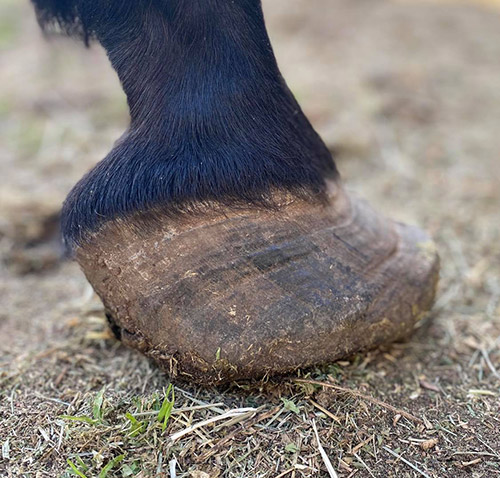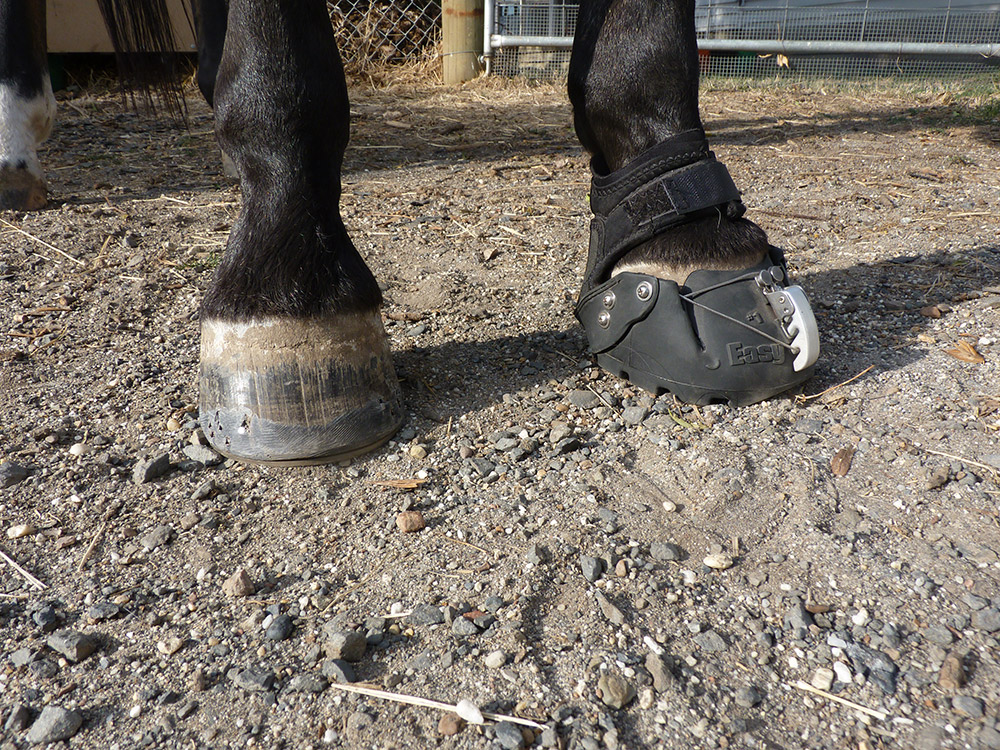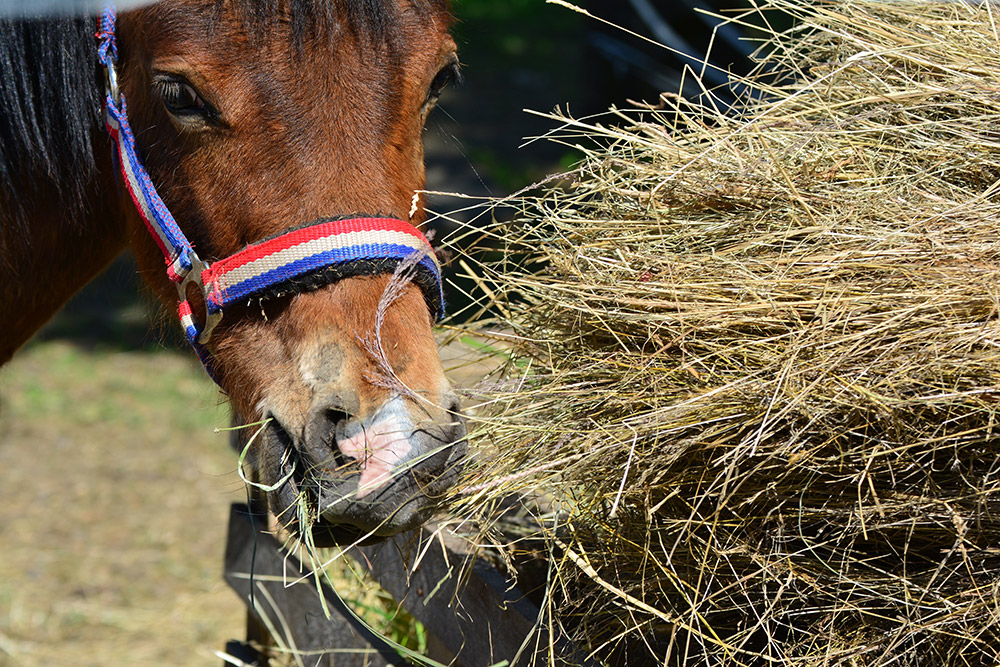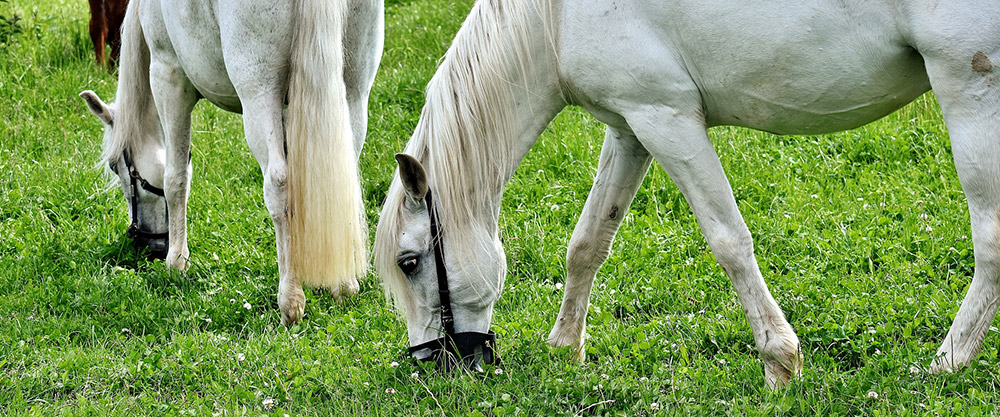Spring is a joyous time, with longer, warmer days presenting abundant opportunities for horse owners to enjoy fun in the sun with our four-legged friends. Unfortunately, it’s also the highest risk season for laminitis; an extremely painful, often chronic, and sometimes fatal disease that can affect horses and ponies of all shapes and sizes.

“Overindulgence in green
grass is certainly not the
only cause of laminitis.”
When it comes to laminitis, no two cases have entirely identical causes, triggers, treatments or ongoing management requirements. Understanding the complex nature of this disease and the importance of managing horses’ diets correctly will help ensure that prevention, rather than treatment, is a horse owner’s primary endeavour all year round, not just in spring!
WHAT IS LAMINITIS?
Laminitis is an inflammation of the laminae of the horse’s foot; they are sensitive, soft tissue structures that attach the pedal or coffin bone to the hoof wall. During the early stages of laminitis, inflammation causes an increase in the distance between the hoof wall and the pedal bone. If the disease advances beyond this point, the fragile structures break down, allowing the pedal bone to rotate downwards away from the front of the hoof wall. In the most severe cases of laminitis the pedal bone can rotate to such a degree that it penetrates the sole. The pedal bone can also sink vertically towards the ground under the influence of the horse’s body weight, resulting in blood supply surrounding the pedal bone to be affected, sometimes permanently.
WHAT CAUSES LAMINITIS?
The causes of laminitis have been the subject of extensive research and debate for many years, due in part to the sometimes complex factors that can work together or independently to cause a laminitic response. While the symptoms of laminitis may present predominantly in the horse’s feet, it is important to understand that laminitis is a pathological condition of a horse’s whole system when seeking to understand the causes, prevention and management of the disease.
Many cases of laminitis are caused by overeating feeds rich in soluble and/or complex carbohydrates, such as cereal grains and lush pastures; for example, the flushes of fast-growing grass experienced during the spring months or after rain events in summer and autumn. However, overindulgence in green grass is certainly not the only cause of laminitis.
When stabled horses or those with limited access to pasture exhibit laminitis, it is generally caused by a diet that is too high in starch and sugar, leading to digestive upset in the large intestine. Starch is usually digested in the small intestine; however, if eaten in excess, they spill over into the large intestine and ferment, resulting in the creation of lactic acid. As the acid builds up and the normal bacteria in the cecum die, endotoxins are released and enter the bloodstream, resulting in damage to the laminae. Sepsis, an infection of an organ such as the lungs, bowel or uterus, mostly post foaling, can also result in bacterial toxins entering the bloodstream with a laminitic outcome.
Laminitis can also be caused by high blood insulin levels relating to an underlying hormonal condition, such as insulin resistance, Cushing’s syndrome or equine metabolic syndrome. Horses with these conditions are more susceptible to laminitis resulting from fructan overload from pasture, as they have little ability to control blood sugar levels; as such, when they consume high fructan loads, it causes a spike in their already high blood insulin, often resulting in laminitis.
Another cause of laminitis is direct trauma, such as the extreme trimming of the hoof, working the horse on hard surfaces such as roads, an infection, swelling or excessive load-bearing. The latter is commonly known as “supporting leg laminitis”; this can arise in situations whereby a horse has a severe leg injury such as a fracture, resulting in the matching leg on the opposite side bearing excessive weight for a prolonged period.
WHAT ARE THE SYMPTOMS?
One of the most significant challenges with laminitis is that by the time the signs of inflammation, swelling, pain and increased blood flow are evident, severe damage to the delicate laminar membranes may have already occurred, hindering the opportunity for a full and quick recovery. As such, if prevention has not been successful, early recognition of laminitic symptoms and subsequent veterinary attention is critically important in limiting the disease’s progression and impact.


“Treatment will vary depending on
the cause of each case of laminitis.”
A laminitic horse shows some or all of these symptoms:
• Lameness, which may be as subtle as a shortened stride
• Reluctance to turn
• Increased digital pulse
• Warm feet; this is most common in the front feet however laminitis can affect all four feet
• Shifting weight from one front foot to the other
• Laminitis stance; front feet are extended forward, with the hind feet placed further under the body than usual as the horse attempts to relieve pressure and pain in the front feet
• A pained or anxious facial expression
• Increased pulse and/or resting respiratory rate
• Elevated temperature
INITIAL AND ONGOING TREATMENT
Treatment will vary depending on the cause of each case of laminitis and any underlying conditions the horse is experiencing; however, veterinary treatment during the early stages will typically involve the use of drugs such as phenylbutazone to reduce inflammation and pain. If the horse has heat in its feet, icing is recommended; if the horse will tolerate standing or placing feet in ice buckets, this can be done for several 10-minute periods per day with 5-minute breaks; alternatively, cold hosing of the feet is a suitable option.
Providing ample bedding in the laminitic horse’s stable or yard will help improve their comfort levels and encourage them to lie down to relieve the pain and pressure in their feet. Hoof boots may also be fitted to provide a cushioning effect.
The involvement of a farrier experienced with laminitic horses is invaluable. In cases where pedal bone rotation has occurred, radiographs taken by the veterinarian should be provided to the farrier so they know precisely what is happening beneath the surface. The farrier may apply heart bar shoes, and will need to trim the laminitic horse’s hooves regularly to ensure that weight remains evenly distributed across the hoof wall and frog.
A laminitic horse should not be exercised or walked as movement can further damage the laminae; however, do allow the horse to move around its stall or yard if it is comfortable to do so, as this will promote circulation which aids healing.
FEEDING THE LAMINITIC HORSE
During a bout of laminitis, it is essential that the horse has no access to any pasture or grain; however, it is a mistake to drastically decrease the laminitic horse’s feed intake, even in cases triggered by obesity. The horse should be fed a roughage-based diet comprised mainly of free choice hay with low non-structural carbohydrate (NSC) sugar content – “low sugar hay”. Cereal hays such as oaten and barley hay should be avoided; rhodes, teff, lucerne and pasture hay are the best choices, and stalky hay should be chosen over leafy hay. Sugar content within these recommended varieties can vary greatly; as such, it is preferable to have a hay analysis performed to confirm the hay has a low NSC content. In addition, soaking the hay will help to reduce the sugar levels.


“Low starch feeds such
as Barastoc Calm Performer
and Barastoc Low GI can
be suitable options.”
If suitable hay is not available, alternative sources of fibre and roughage such as Speedi-beet are excellent choices. Speedi-beet can be mixed with lucerne chaff or fed on its own; being highly palatable, it is a very handy feed to mix with salt, a balancer pellet, plus any medications or supplements the horse requires, in order to ensure the horse consumes these.
To ensure the removal of grain and pasture from the horse’s diet during a bout of laminitis does not result in an unbalanced diet being fed, or the horse being deprived of essential nutrients, a balancer pellet such as KER AllPhase and Barastoc KER Stud Balancer can be fed. This is an effective way to provide essential amino acids, vitamins and minerals with minimal calorific intake. Ensuring the horse’s dietary needs are met will support their recovery, aid overall good health and assist their immune system.
Since laminitis is an inflammatory condition of the hoof, reducing the inflammation is the crucial element in preventing and treating the condition. Feeding omega-3 supplements like KER EO-3 to laminitic horses will improve the critical ratio of omega-6 to omega-3 (<4:1). The lower ratio of omega-6/omega-3 fatty acids is essential not only in reducing the risk of many inflammatory conditions, but also in improving glucose tolerance.
PREVENTING LAMINITIS
As the understanding of the disease increases, so do the number of horses that recover from laminitis and live happy, pain-free, productive lives. However, horses that have suffered laminitis in the past are significantly more likely to suffer laminitis again in the future than those who haven’t; as such, these horses will need to be fed a laminitis-safe diet and receive regular farrier attention for the rest of their lives.
Horses identified as being at high risk of laminitis have similar management requirements as recovered horses when it comes to feeding and foot care. Any horse owners who have nursed a horse through recovery from laminitis will vouch for the value of knowing whether a horse is at risk of laminitis, and preventing the disease through appropriate feed management.
Ponies and smaller breeds of horses, such as quarter horses, are at greatest risk of laminitis, as are “good doers” who gain weight easily. Horses with metabolic issues, as described earlier in the “Causes of Laminitis” section of this article, are also at higher risk.
Understanding the body scoring system and keeping previous laminitis survivors and at-risk horses at a score of between 2 and 3 is advisable. Barastoc has an excellent body condition score chart.
While pasture is not completely off-limits for susceptible horses, restricting access is essential, particularly during spring and autumn. Avoid short, stressed or frosted grass, and consider using a grazing muzzle for all or part of the day.
Fructan levels in grasses vary significantly during different times of the day and are also influenced by the amount of sunlight. Cold nights followed by sunny days are particularly risky whereas spikes in fructan levels are not as extreme on overcast days; ideally, a high-risk horse in high-risk conditions should have a maximum of 1-2 hours access to grass, and no access between 10 am and midnight.
The same principles utilised during a bout of laminitis continue to apply; the diet should be roughage based, with a low NSC content of under 10%. For some horses, such as ponies and those that are either not in work or have a very low workload, feeding low sugar hay and/or Speedi-beet, a feed balancer or mineral supplement such as Barastoc Groom, and controlled grazing may suffice.
However, those that are underweight, have a condition such as Cushing’s disease and associated muscle loss, and those in moderate workload will usually require more calories and protein. Low starch feeds, such as Barastoc Calm Performer and Barastoc Low GI, can be suitable options for these horses. It is important to consider the horse’s diet as a whole; while individual ingredients may have a higher NSC content than others, if these are fed in conjunction with low sugar hay, and each meal remains below 10% NCS overall, this is unlikely to trigger a spike in blood sugar levels and is considered appropriate for both laminitis survivors and those at risk of the disease.
Laminitis is never good news; however, with good management, close observation and an understanding of the disease and its risk factors, it can be halted or prevented without permanently impacting a horse or pony’s chance to enjoy a happy, pain-free and productive life. EQ
YOU MIGHT ALSO LIKE TO READ:
Foal diarrhoea (Don’t panic!) (In this issue – by Dr Maxine Brain)



